Cisco Linksys WPC11-V29 2.4 GHz WLAN PCMCIA Card User Manual
Cisco-Linksys, LLC 2.4 GHz WLAN PCMCIA Card
User manual
Preliminary User manual
Page 1 of 10
Intersil ISL37305P PC Card
User Manual
Version 0.1
Preliminary User manual
Page 2 of 10
Table of Contents
0-INTRODUCTION ....................................................................................................3
1-INSTALLATION......................................................................................................3
1.1 INSTALLING THE PC CARD INTO THE HOST PC NOTEBOOK.............................3
1.2 INSTALLING THE SOFTWARE DRIVERS ................................................................3
1.3 WIRELESS LAN INSTALLATION GUIDE LINES AND AUTHORIZATION FOR USE .7
2-REGULATORY INFORMATION.........................................................................7
2.1 FCC INFORMATION TO USER .............................................................................7
2.2 FCC GUIDELINES FOR HUMAN EXPOSURE ........................................................7
2.3 FCC ELECTRONIC EMISSION NOTICES..............................................................7
2.4 FCC RADIO FREQUENCY INTERFERENCE STATEMENT.....................................8
2.5 EXPORT RESTRICTIONS .......................................................................................8
2.6 EUROPE - EU DECLARATION OF CONFORMITY.................................................9
3-TECHNICAL SPECIFICATIONS.......................................................................10
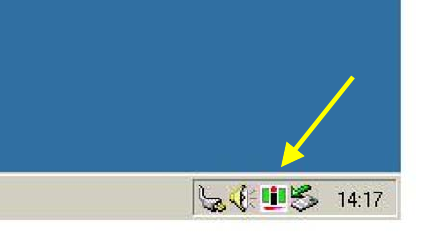
Preliminary User manual
Page 3 of 10
0-Introduction
The Intersil ISL37305P WLAN PC card is a complete wireless high speed Network Interface Card
(NIC) utilizing the Intersil PRISM® 2.5 Direct Sequence Spread Spectrum (DSSS) Wireless
Transceiver chip set.
It provides a complete PRISM 2.5 reference design evaluation platform of hardware and software to
system providers or integrators requiring wireless data communications capability.
1-Installation
1.1 Installing the PC Card into the host PC Notebook
a-insert PC Card into PCMCIA slot
1.2 Installing the software drivers
a-Start windows
b-When windows detects new hardware and asks for drivers, point to directory where the Intersil driver
is located (for example floppy drive, cdrom , harddisk) to install.
c-after drivers are installed, restart windows
d-the Intersil WLAN icon will appear in system tray on the bottom right of the screen (see yellow
arrow in fig. 01)
fig, 01: Intersil WLAN icon
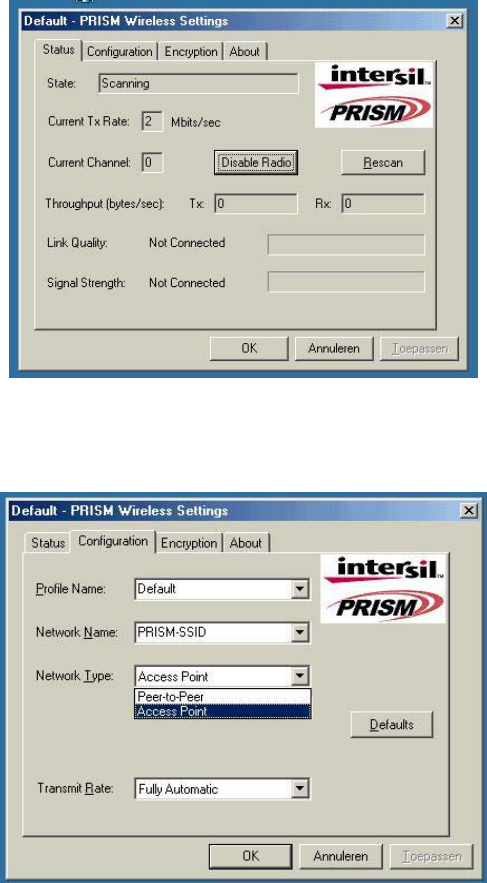
Preliminary User manual
Page 4 of 10
e-double click the Intersil WLAN icon to open the WLAN settings, the following window will appear
(see fig.02)
fig, 02: Intersil WLAN settings window
f-click on configuration tab and select which type of network is required (access point or Peer-to-peer
mode), see fig. 03.
fig, 03: WLAN network type setting window
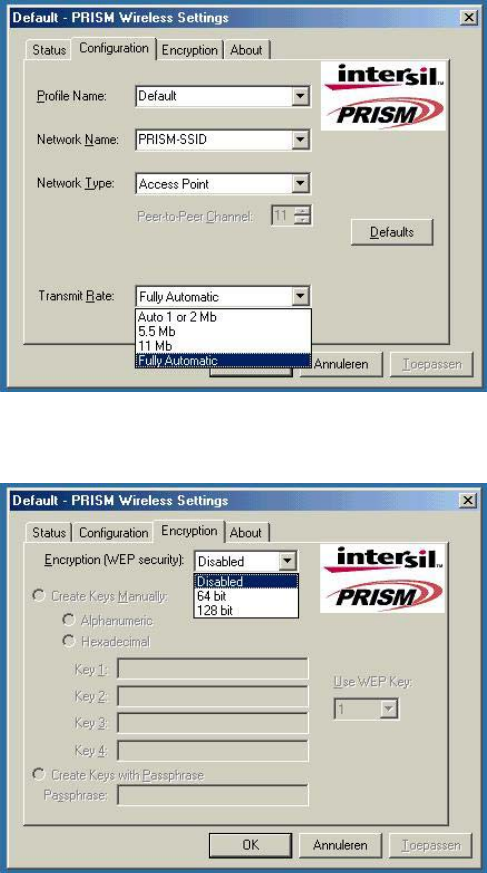
Preliminary User manual
Page 5 of 10
g-select what TX rate is required (default setting is fully automatic) see fig. 04.
fig, 04: WLAN tx rate setting window
h-select what encryption type is required, 64 or 128 bit WEP (default setting is disabled) see fig. 05.
fig, 05: WLAN encryption rate setting window
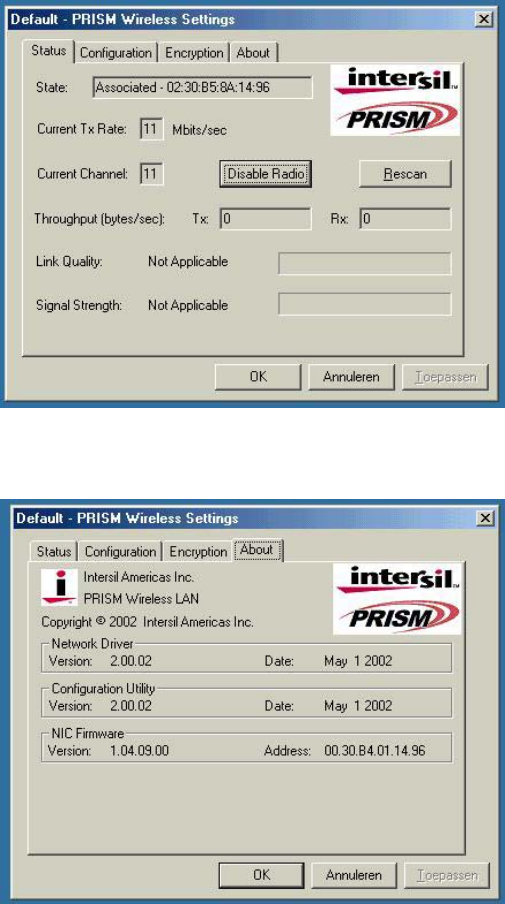
Preliminary User manual
Page 6 of 10
i-click on the status tab to see the connection status (fig.06).
fig, 06: WLAN network status
j-click on the about tab to see the software drivers versions and MAC address (fig.07).
fig, 07: WLAN driver and MAC addres information
Preliminary User manual
Page 7 of 10
1.3 Wireless LAN installation guide lines and Authorization for use
Installation and use of this Wireless LAN device must be in strict accordance with the instructions
included in the user documentation provided with the product. Any changes or modifications made to
this device that are not expressly approved by Intersil may void the user’s authority to operate the
equipment. Intersil is not responsible for any radio or television interference caused by unauthorized
modification of this device, or the substitution or attachment of connecting cables and equipment other
than specified. It is the responsibility of the user to correct any interference caused by such
unauthorized modification, substitution or attachment. Intersil and its authorized resellers or
distributors will assume no liability for any damage or violation of government regulations arising from
failing to comply with these guidelines.
The use of Wireless LAN devices may be restricted in some situations or environments for example:
* On board of airplanes, or
* In an explosive environment, or
* In case the interference risk to other devices or services is perceived or identified as harmful.
In case the policy regarding the use of Wireless LAN devices in specific organizations or environments
(e.g. airports, hospitals, chemical/oil/gas industrial plants, private buildings etc.) is not clear, please
first verify authorization to use these devices prior to operating the equipment.
2-Regulatory information
2.1 FCC Information to User
This product does not contain any user serviceable components and is to be used with approved
antennas only. Any product changes or modifications will invalidate all applicable regulatory
certifications and approvals
2.2 FCC Guidelines for Human Exposure
Warning:
In order to comply with RF exposure limits established in the ANSI C95.1 standards, the user is
advised to maintain a distance of at least 1 inch (2.5 cm) from the antenna of this device while it is in
use. If the antenna is positioned less than 1 inch (2.5 cm) from the user, it is recommended that the
user limits the exposure time.
2.3 FCC Electronic Emission Notices
This device complies with part 15 of the FCC Rules.
Operation is subject to the following two conditions:
1. This device may not cause harmful interference
2. This device must accept any interference received, including interference that may cause undesired
operation.
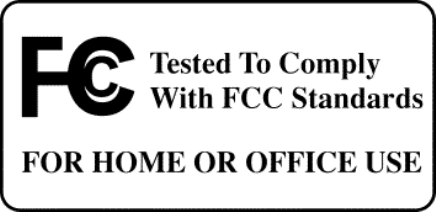
Preliminary User manual
Page 8 of 10
2.4 FCC Radio Frequency Interference statement
This equipment has been tested and found to comply with the limits for a class B digital device,
pursuant to Part 15 of the FCC Rules. These limits are designed to provide reasonable protection
against harmful interference when the equipment is operated in a commercial environment. This
equipment generates, uses and can radiate radio frequency energy and, if not installed and used in
accordance with the instructions, may cause harmful interference to radio communications.
Operation of this equipment in a residential area may cause harmful interference, in which case the user
will be required to correct the interference at his own expense.
If this equipment does cause harmful interference to radio or television reception, which can be
determined by turning the equipment off and on, the user is encouraged to try to correct the
interference by one or more of the following measures:
• Reorient or relocate the receiving antenna
• Increase the separation between the equipment and receiver
• Connect the equipment into an outlet on a circuit different from that to which the receiver is
connected
• Consult the dealer or an experienced radio/TV technician for help
2.5 Export restrictions
This product or software contains encryption code which may not be exported or transferred from the
US or Canada without an approved US Department of Commerce export license.

Preliminary User manual
Page 9 of 10
2.6 Europe - EU Declaration of Conformity
This device complies with the essential requirements and other relevant provisions of the European
R&TTE Directive 1999/5/EC.
Compliance to essential test suites is met per standards:
R&TTE Harmonized Standard Description
LVD specification
EN 60950
EN 60950,ed. (1992), incl A1(1993), A2(1993), A3(1995) and
A4(1997)
Safety of information technology equipment, including electrical
business equipment.
Meets R&TTE directive art. 3.1.a of essential requirements on
protection of the health and sefety of the user.
ETSI EMC specification
ETSI EN 301 489-1 V1.2.1
(2000-08)
ETSI EN 301 489-17 V1.1.1
(2000-09)
Electromagnetic compatibility and Radio spectrum Matters (ERM);
ElectroMagnetic Compatibility (EMC) standard for radio equipment
and services;
Part 1: Common technical requirements
Part 17: Specific conditions for Wideband data and HIPERLAN
equipment
Meets R&TTE directive art. 3.1.b of essential requirements on
protection with respect to Electro Magnetic Compatibility.
ETSI RF specification
ETSI EN 300 328
Part 1 V1.2.2 (2000-07)
ETSI EN 300 328
Part 2 V1.1.1 (2000-07)
Electromagnetic compatibility and Radio spectrum Matters (ERM);
Wideband Transmission systems; data transmission equipment
operating in the 2,4 GHz ISM band and using spread spectrum
modulation techniques;
Part 1: Technical characteristics and test conditions
Part 2: Harmonized EN covering essential requirements
under article 3.2 of the R&TTE Directive
Meets R&TTE directive art. 3.2.a on effective use of spectrum so as to
avoid harmful interference.
Important Notice :
This device is a 2.4 GHz low power RF device intended for home
and office use in EU and EFTA member states. In some EU /
EFTA member states some restrictions may apply. Please
contact local spectrum management authorithies for further
details before putting this device into operation.

Preliminary User manual
Page 10 of 10
3-Technical Specifications
Radio Technology IEEE 802.11b Direct Sequence Spread Spectrum
Operating Frequency 2400-2497MHz ISM band
Modulation Schemes DQPSK, DBPSK and CCK
Channel Available 11 channels for United States
13 channels for Europe
14 channels for Japan
Data Rate 11Mbps with fall back rates of 5.5, 2 and 1Mbps
Media Access Protocol CSMA/CA with ACK
Transmitter RF Output Power < 20.0 dBm EIRP (typical) including antenna gain
Antenna Type Internal inverted F diversity antennas with 2 dBi rated gain
Operating Voltage 3.3 VDC via PC PCMCIA slot
Interface PCMCIA
Device driver Support Microsoft® Windows® 98, NT, 2000, CE, ME, XP and LINUX®